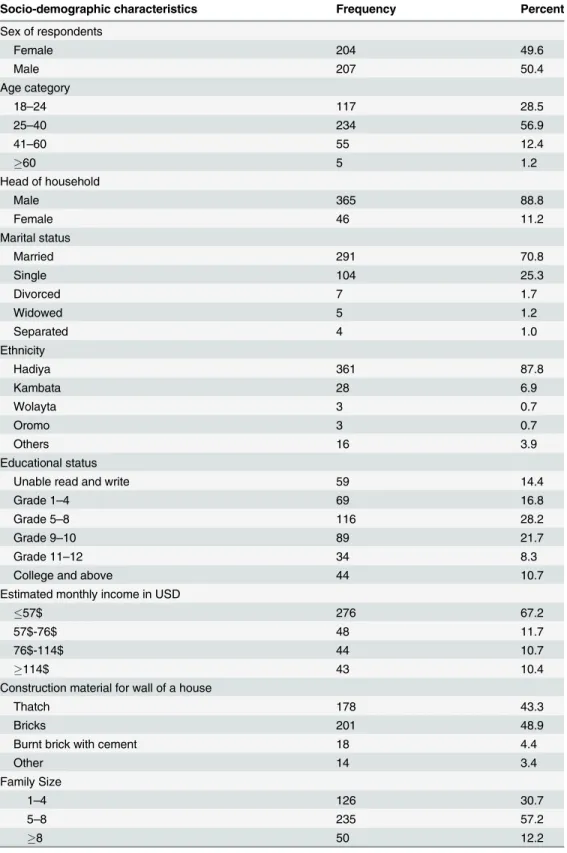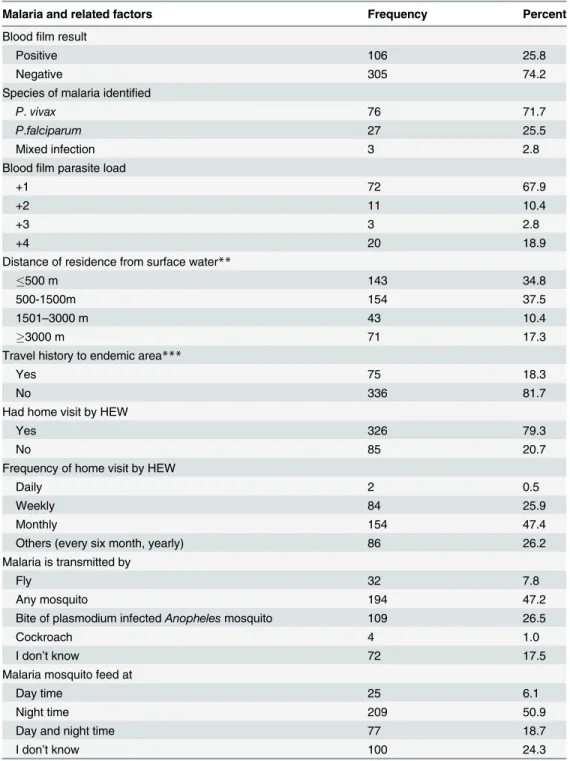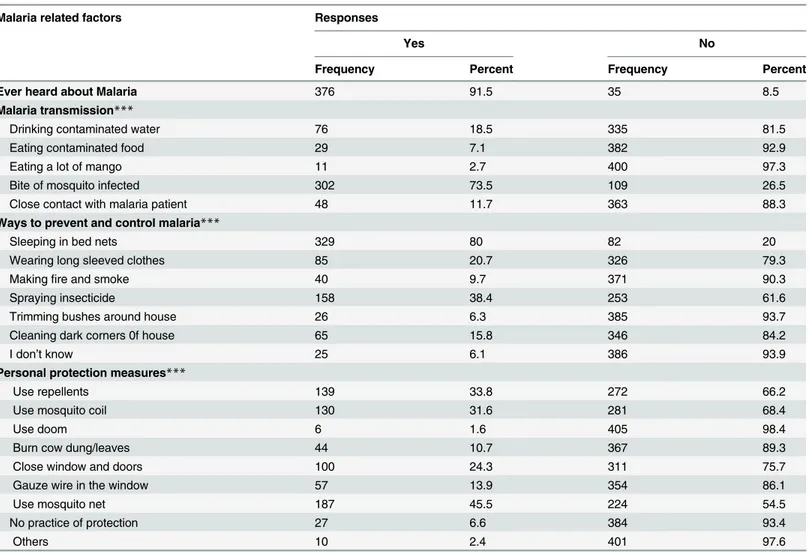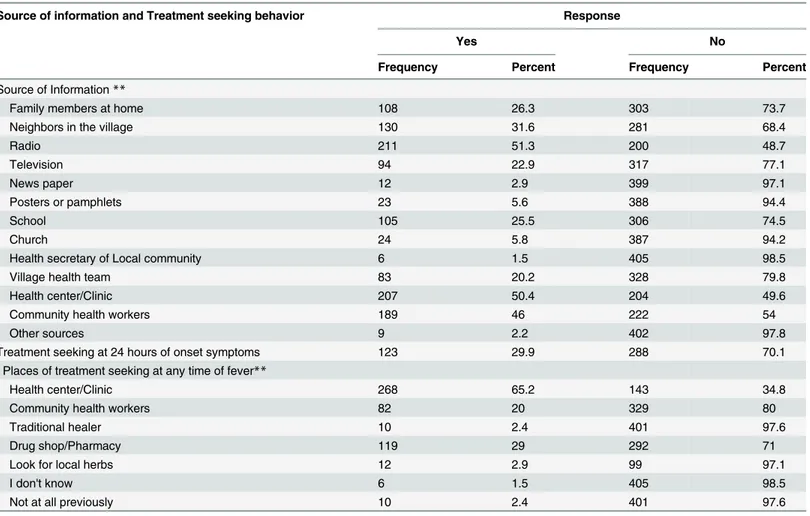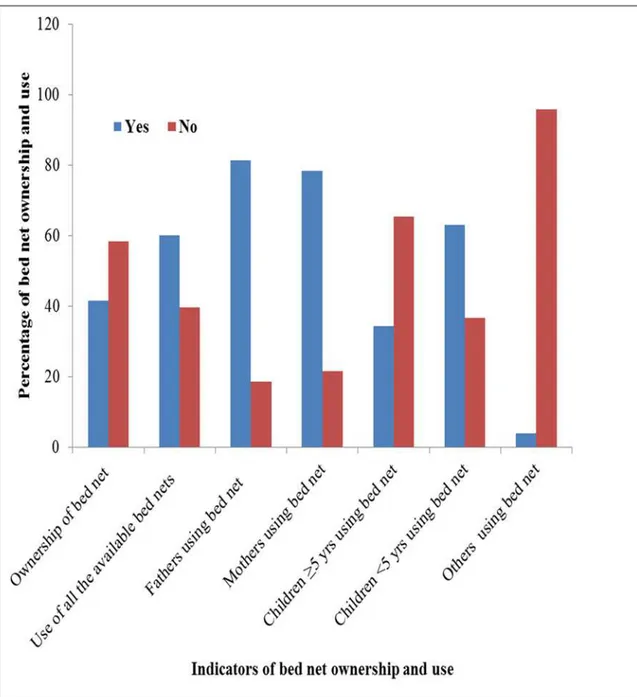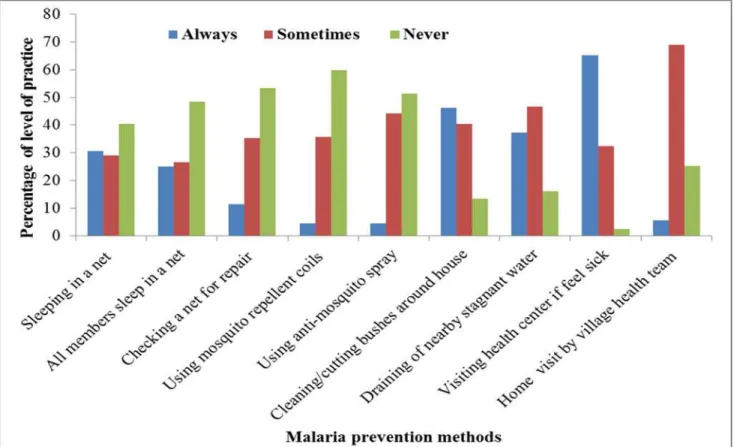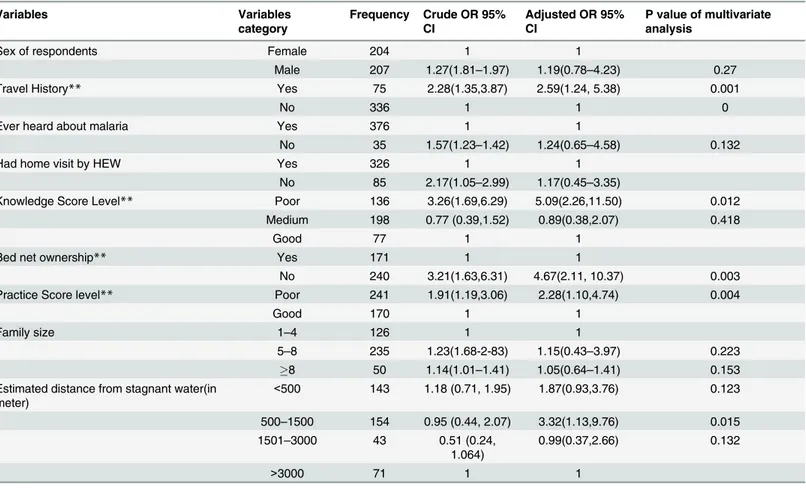Magnitude of Malaria and Factors among
Febrile Cases in Low Transmission Areas of
Hadiya Zone, Ethiopia: A Facility Based Cross
Sectional Study
Romedan Kedir Delil1☯, Temesgen Kale Dileba2☯, Yitagesu Aweke Habtu2☯*, Terefe Fuge Gone3,2‡, Taye Janfa Leta4,2‡
1Department of Clinical Nursing, Hossana College of Health Sciences, Hossana, Ethiopia,2Department of Health Informatics, Hossana College of Health Sciences, Hossana, Ethiopia,3Department of Medical Laboratory Sciences, Hossana College of Health Sciences, Hossana, Ethiopia,4Department of Public Health, Hossana College of Health Sciences, Hossana, Ethiopia
☯These authors contributed equally to this work.
‡These authors also contributed equally to this work. *yitagesuh@yahoo.com
Abstract
Background
Despite a remarkable decline in morbidity and mortality since the era of malaria roll back strategy, it still poses a huge challenge in Ethiopia in general and in Hadiya Zone in particu-lar. Although, there are data from routine health management information on few indicators, there is scarcity of data showing magnitude of malaria and associated factors including knowledge and practice in the study area. Therefore, the aim of this study was to assess magnitude and factors affecting malaria in low transmission areas among febrile cases attending public health facilities in Hadiya Zone, Ethiopia.
Methods
A facility based cross-sectional study was conducted in Hadiya Zone from May 15 to June 15, 2014. Simple random sampling was used to select the health facility while systematic random sampling technique was used to reach febrile patients attending public health facili-ties. Data were collected by a pre-tested structured questionnaire containing sections of socio demographic risk factors and knowledge and prevention practices of malaria. Data were entered to Epi-Info software version 3.5.4 and exported to SPSS version 16 for descriptive and logistic regression analysis.
Results
One hundred six (25.8%) of participating febrile patients attending at sampled health facili-ties were found to have malaria by microscopy. Of which,P.vivax,P.falciparumand mixed infection accounted for 76(71. 7%), 27 (25.5%) and 3 (2.8%), respectively. History of travel to malaria endemic area, [AOR: 2.59, 95% CI: (1.24, 5.38)], not using bed net, [AOR: 4.67, 95%CI:, (2.11, 10.37)], poor practice related to malaria prevention and control, [AOR: 2.28, a11111
OPEN ACCESS
Citation:Delil RK, Dileba TK, Habtu YA, Gone TF, Leta TJ (2016) Magnitude of Malaria and Factors among Febrile Cases in Low Transmission Areas of Hadiya Zone, Ethiopia: A Facility Based Cross Sectional Study. PLoS ONE 11(5): e0154277. doi:10.1371/journal.pone.0154277
Editor:Luzia Helena Carvalho, Centro de Pesquisa Rene Rachou/Fundação Oswaldo Cruz (Fiocruz-Minas), BRAZIL
Received:January 7, 2016
Accepted:April 10, 2016
Published:May 3, 2016
Copyright:© 2016 Delil et al. This is an open access article distributed under the terms of theCreative Commons Attribution License, which permits unrestricted use, distribution, and reproduction in any medium, provided the original author and source are credited.
Data Availability Statement:All relevant data are within the paper and its Supporting Information files.
(95%CI: (1.10, 4.74)], poor knowledge about malaria, [AOR: 5.09,95%CI: (2.26,11.50)] and estimated distance of stagnant water near to the residence, [AOR: 3.32, (95%CI: (1.13, 9.76)] were significantly associated factors of malaria positivity in the study.
Conclusion
The present study revealed that malaria is still a major source of morbidity in the study area among febrile illnesses. Poor level of knowledge, poor prevention practices, not using bed net, travel history to endemic areas and residing near stagnant water were associated fac-tors with malaria positivity in the study area. Therefore, implementers, policy makers and stakeholders should strengthen the services provided by the community health develop-ment army, health extension service and health facilities services focusing on increasing malaria intervention coverage and mobilization of information, education and communica-tion to increase knowledge about malaria transmission, prevencommunica-tion and control practices.
Background
Globally, an estimated 3.3 billion people are at risk of being infected with malaria and 1.2 billion are at high risk (>1 in 1000 chance of getting malaria in a year). According to the 2014 WHO report, 198 million cases of malaria occurred globally (uncertainty range 124–283 million) and the disease led to 584 000 deaths (uncertainty range 367 000–755 000)[1]. Although facts showed a decline of malaria burden, decreases in case incidence and mortality rates were slowest in coun-tries that had the largest numbers of malaria cases and deaths in 2000. The global burden of mor-tality is dominated by countries in sub-Saharan Africa, where an estimated 90% of all malaria deaths occur, and in children aged under 5 years, who account for 78% of all deaths [1].
Despite a remarkable decline in morbidity and mortality due to malaria as of malaria roll back era, it still poses huge challenge. Malaria is ranked as the leading communicable disease in Ethiopia, accounting for about 30% of the overall Disability Adjusted Life Years lost.[2]. Accord-ing to records from the Ethiopian Federal Ministry of Health, 75% of the country is malarious with about 68% of the total population living in areas at risk of malaria. That is, more than 50 million people are at risk from malaria [2,3], and four to five million people are affected by malaria annually, of these,P.falciparumandP.vivaxaccounts for 60% and 40% of cases respec-tively. However, the malaria species distribution varies with spatial geography [4,5] and the risk has not recently been revised considering possible changes such as urbanization and land use [5].
The Federal Ministry of Health (FMoH) of Ethiopia plans a strategy to achieve malaria elim-ination within specific geographical areas with historically low malaria transmission and zero deaths due to malaria in areas with malaria transmission by 2020 [6]. Because there were gaps in the surveillance system, official estimates of the true burden of malaria in Ethiopia needs supplementary evidences with regard to malaria magnitude by species. Moreover, there is no report on active case detection of reactive and febrile cases at community level and mass screening in intervention policies and strategies in the country[1].The health management information system of Ethiopia enables only to estimate from both laboratory and clinically confirmed malaria morbidity reports [7]. One epidemiological thematic review conclude that in addition to the magnitude of disease, the distribution species of malaria has to be given equal weight for the prevention, control and elimination of malaria [2].
In Ethiopia, coexistence of bothP.falciparumandP.vivaxcan create challenge in preven-tion, control and elimination of the disease [8]. The current focus of control in Africa including
Ethiopia is justifiably on P. falciparum, by far the most pathogenic of the five human malarias, contributing to over 95% of the world’s mortality from malaria [8]. However, far less is known about the epidemiological distribution or clinical consequences ofP.vivax[2].
In the previous couple of years, malaria indicators surveys have been conducted and surveil-lance and facility based reports used to describe the burden of malaria in Ethiopia. However, facility based studies indicated that there are significant gaps in continuous laboratory supplies and reagents, and lack of training and supportive supervision [9]. Another study conducted in Kenya showed more than half of the febrile cases were wrongly diagnosed as if they were truly clinical malaria [10]. Continuous research evidences are needed through systematic scientific studies for malaria control, prevention and elimination interventions. Moreover, in Ethiopia where there is no active case detection of reactive and febrile cases at community level, a facility based study has indispensable support for area and context specific intervention [8].
Despite impressive gains in malaria intervention coverage for sub-Saharan Africa, millions of people still do not receive the services they need. Lack of access to an ITN or IRS, gaps in providing universal access to diagnostic testing and treatment, decrease in health care service utilization due to weaknesses in health systems(decrease in health care seeking), resistance to insecticides used in ITNs and IRS, anti-malarial drug resistance [1] remains the principal barri-ers to protection from mosquito bites.
Ethiopia is a very ecologically diverse country and harbors many different epidemiological profiles for malaria transmission. In epidemic-prone areas there is significant heterogeneity in transmission risk, and as a result, elimination strategies will not be uniform throughout the country. Each area may require its own unique interventions, which in turn would be delivered progressively until elimination can be achieved [6]. Due to these challenge, this study tried to identify the magnitude of malaria species among febrile cases attending public health facilities to support the existing malaria prevention, control and elimination strategies of the area.
Treatment seeking behavior is also important for early case detection and management so that transmission would be reduced. In Ethiopia, the national Malaria Indicator Survey (MIS) undertaken in 2011 showed that over 40% of fevers were treated within 24/48 hours with an anti-malarial drugs outside the formal public health reporting system [11]. These features of malaria treatment pose challenges to case-management but equally to the reliability of active case detection completeness [8]
Furthermore, attention of malaria burden in low transmission settings is lower which may pave the way for vector control and integrated vector management [12]. Despite this, the pre-ceding malaria researches in Ethiopia majorly focused on endemic transmission areas and as a result, there have been a scarcity of studies addressing magnitude, distribution of species and factors in low transmission areas [13–14].
Although, there are data from routine health management information on few indicators, there is a need for area and context specific data showing magnitude of malaria and associated factors including knowledge and practice essential to achieve Ethiopia’s strategic plan [6]. Several factors including ownership and utilization of LLITNS, knowledge and practice of the commu-nity, and socio-economic, treatment seeking behavior, socio-demographic, environmental factors need to be assessed with regard to malaria status. Studies revealed that knowledge and practices about malaria, household location for stagnant water sources, bed net utilization, age, and travel history, are some of the factors associated with malaria [11,15,16,17,18].
species distribution and factors associated with malaria status among febrile cases in low trans-mission areas of Hadiya zone in Ethiopia. The finding will contribute for supplementary infor-mation for policy makers and implementers as well as scientific society to support malaria control and elimination strategy.
Methods
Study area
This study was conducted in governmental health facilities found in Hadiya Zone, Southern Ethiopia. The study area is located in 7030’(750) north latitude and 37045’(37.750) east longi-tude with an average elevation of 2,106 meters above sea level. According to the geo malaria category of the country, the study area is under the classification of low transmission areas with expected sporadic epidemics every few years [4]. Eighty nine percent of the population lives in rural area and only 10.7% live in urban areas. The zone has one zonal hospital, three primary hospitals under construction and three hundred health post each expected to serve average 1 million people, 60,000 to 100,000 people, 15,000 to 25,000 and 3,000 to 5,000 people, respec-tively. According to the report of the zonal health bureau, malaria is one of the leading causes of morbidity among outpatient and inpatient departments of all health facilities.
Study Design
Facility based Cross-Sectional study was applied from May to June, 2014.
Sample Size and Sampling techniques
The minimum sample size for the study was estimated by using single population proportion formula [19] taking 95% confidence level (CI), (Z (1-ά/2) = 1.96), 50% expected proportion of
slide positivity (p = 0.5) to maximize the sample size because there was no previous proportion of slide positivity near the study area, 5% margin of error (d = 0.05). Using the above assump-tions, the sample size was calculated as follows.
n¼ðZ1 a
2Þ 2
Pð1 PÞ
d2
n¼ð1:96Þ
2
0:5ð1 0:5Þ
ð0:05Þ2 ¼ 384
and 10% (38) non-response rate, a minimum sample of 422 participants were needed. The study was conducted in twelve health centers accounting 20% of all health centers (60 health centers) found in the Zone. Health facilities were selected using simple random sam-pling by assuming they are nearly similar in terms of malaria burden, catchment population demographic risk factors, and access to malaria prevention to get representative participants. A systematic random sampling technique was used to reach febrile patients attending in selected health centers to get a representative understanding of malaria knowledge, practice and related factors among the febrile cases of population in Hadiya Zone.
Data Collection
During data collection, the prior five days average number of febrile cases were taken then multiplied by the data collection period to determine the average total number of febrile cases. Then, the total value was divided by the sample size allocated for each health facility to deter-mine Kthvalues and 1 up to K element were selected by lottery method. Patients were first clin-ically diagnosed to rule out history of fever according to diagnosis protocol by trained clinical nurses/health officer’s staff existing in selected health facilities [20]. Those participants eligible to be included were selected consecutively based on a systematic interval. Febrile adults whose age was greater than 18 years and care givers of those less than 18 years were interviewed about socio-demographic, risk factors including knowledge and practices of malaria.
After the interview was complete, blood slide samples were taken and examined by 12 trained laboratory technologists of existing staff at health facilities. Then, blood slides were diagnosed for malaria parasite by direct microscopy techniques according to National Malaria diagnosis Guideline (NMG) of malaria guideline i.e. blood samples were obtained through fin-ger prick method for thick and thin smears [20]. The blood smears were prepared on micro-scope slides and stained using 10% Giemsa to be examined under 100x micromicro-scopes for the presence of malaria parasites [21]. If one or more asexual stage of plasmodium (trophozoite, ring stage, merozoite and/or gametocyte) is/are present, it was taken as a positive result. Five percent of the slides were randomly selected and then blindly checked for consistency by expe-rienced medical laboratory technologist.
Operational Definitions
Poor Knowledge. When a knowledge score is equal to or less than first quartile of the total
score of 15 item questions on areas of malaria prevention, control, transmission and health seeking behaviors.
Medium Knowledge. When a knowledge score is between the first and second quartile of
the total score of 15 item questions on areas of malaria prevention, control, transmission and health seeking behaviors.
Good Knowledge. When a knowledge score is greater than third quartile of the total score
of 15 item questions on areas of malaria prevention, control, transmission and health seeking behaviors.
Poor Practice. When a reported practice score is less or equal to first quartile of the total
score of 7 item questions on areas of malaria prevention, control, transmission and health seek-ing behaviors.
Good Practice. When a reported practices score is greater than third quartile of the total
score of 7 item questions on areas of malaria prevention, control, transmission and health seek-ing behaviors.
Parasite density. If 1–10 parasites per 100 thick high power fields, it was taken as +1, 11–
100 parasites per 100 high power fields +2, 1–10 parasites in every high power field +3 and more than 10 in every high power field +4 [20]
Ethical Consideration
Data Processing and Analysis
The collected data were cleaned and checked for consistencies and completeness then entered use EPI info version 3.5.4 and exported to SPSS 16. Both descriptive and logistic regression was used to identify factors. Standard multiple regression was used to identify how much variance in test positivity status the factors were able to explain as a group or block [22]. All variables which showed statistically significant results with malaria status in binary logistic regression were entered to multivariate logistic regression to control for confounders.
Result
Socio-demographic characteristics
A total 411 of 422 participants were involved in the survey making the response rate of 97.4%. Three hundred sixty six (89%) were febrile adults while the rest were caregivers of febrile chil-dren under 18. The age of the respondents ranged from 18 years to 70 years with a mean age of 30.7 years. Almost equal number of males (50.4%) and females (49.6%) were involved in the study giving a male to female ratio of 1:1. The average monthly income of the study population ranged from 4.8$ to 390.5$ with mean income of 54$ US dollar (Table 1).
Malaria and related factors
One hundred and six respondents had malaria which gave a slide positivity of 25.8% in the study area. Out of the 106 cases, 76 (71.7%), 27 (25.5%), 3 (2.8%) wereP.vivax,P.falciparum
and were mixed infections respectively. Microscopic examination also revealed the parasite load of the reactive cases. Accordingly, 72(67.9%) of the cases were low (+1) and the remaining 10.4% and 21.7% of the cases carried moderate (+2) and high (+3 or +4) parasites load, respec-tively (SeeTable 2).
Knowledge about malaria and practice of its prevention methods
Regarding knowledge of respondents on the way of malaria transmission, only 26.5% of the respondents replied that malaria is transmitted by the bite ofPlasmodiuminfected mosquitoes (SeeTable 2). On the other hand, 80% of the respondents reported that sleeping under bed net prevents malaria transmission from infected person to non-infected person (SeeTable 3).
Regarding awareness, the majority of participants (91.5%) had ever heard about malaria from different sources of information. Accordingly, the major sources of information were radio transmission and health center/clinic which accounts for 51.3% and 50.4%, respectively.
Only 29.9% % of participants had sought treatment within the first 24 hours of symptom onset while the rest had delayed treatment seeking behavior. Including the recommended time of treatment seeking behavior (24 hours from onset of symptom), participants were also asked about where they go for treatment when they had experienced similar symptoms before. Based on this, 268 (65.2%) of the respondents reported that they had sought treatment from health center/clinic, 119 (29%) of them had sought from drug shop/pharmacy and 80 (20%) of them had sought from community health workers mainly health extension workers at any time with similar febrile illnesses (seeTable 4).
Bed net Ownership, Utilization and other prevention practices
Table 1. Socio-demographic characteristics among attendants of public health facilities in Hadiya Zone, Southern Ethiopia, 2014 (n = 411).
Socio-demographic characteristics Frequency Percent
Sex of respondents
Female 204 49.6
Male 207 50.4
Age category
18–24 117 28.5
25–40 234 56.9
41–60 55 12.4
60 5 1.2
Head of household
Male 365 88.8
Female 46 11.2
Marital status
Married 291 70.8
Single 104 25.3
Divorced 7 1.7
Widowed 5 1.2
Separated 4 1.0
Ethnicity
Hadiya 361 87.8
Kambata 28 6.9
Wolayta 3 0.7
Oromo 3 0.7
Others 16 3.9
Educational status
Unable read and write 59 14.4
Grade 1–4 69 16.8
Grade 5–8 116 28.2
Grade 9–10 89 21.7
Grade 11–12 34 8.3
College and above 44 10.7
Estimated monthly income in USD
57$ 276 67.2
57$-76$ 48 11.7
76$-114$ 44 10.7
114$ 43 10.4
Construction material for wall of a house
Thatch 178 43.3
Bricks 201 48.9
Burnt brick with cement 18 4.4
Other 14 3.4
Family Size
1–4 126 30.7
5–8 235 57.2
8 50 12.2
Table 2. Malaria and related factors among attendants of public health facilities in Hadiya Zone, Southern Ethiopia, 2014 (n = 411).
Malaria and related factors Frequency Percent
Bloodfilm result
Positive 106 25.8
Negative 305 74.2
Species of malaria identified
P.vivax 76 71.7
P.falciparum 27 25.5
Mixed infection 3 2.8
Bloodfilm parasite load
+1 72 67.9
+2 11 10.4
+3 3 2.8
+4 20 18.9
Distance of residence from surface water**
500 m 143 34.8
500-1500m 154 37.5
1501–3000 m 43 10.4
3000 m 71 17.3
Travel history to endemic area***
Yes 75 18.3
No 336 81.7
Had home visit by HEW
Yes 326 79.3
No 85 20.7
Frequency of home visit by HEW
Daily 2 0.5
Weekly 84 25.9
Monthly 154 47.4
Others (every six month, yearly) 86 26.2
Malaria is transmitted by
Fly 32 7.8
Any mosquito 194 47.2
Bite of plasmodium infectedAnophelesmosquito 109 26.5
Cockroach 4 1.0
I don’t know 72 17.5
Malaria mosquito feed at
Day time 25 6.1
Night time 209 50.9
Day and night time 77 18.7
I don’t know 100 24.3
**Estimated by one reported trip travel time (1 minute for every 30 meters for educated participants and pointing the available distance during data collection for non-educated and converting to similar units for permanent and temporary stored water sources in the last 30 days.
***Judged by asking when and where they had travelled in the last 30 days and determine based on risk classification of the Zone
having a bed net. The study also revealed that more than half of the individuals who owned bed nets (60.2%) reported that they were using it appropriately. The major reasons reported for not using bed net were lack of supply (50.8%), inadequate number to family size (38.5%), oldness of bed nets (7.7%) and participants’perception of absence of malaria in the area 2 (3.1%) (Fig 1).
Participants were also interviewed to provide multiple practices for malaria prevention. One hundred ninety, (46.2%) of the study participants clean/cut bushes around their house and 153 (37.2%) of them drain stagnant water near their home, 200 (48.7%) household spray at every six month, 165 (40.2%) used both traditional mosquito repellents and other methods (Fig 2). More than half of the respondents (53.3%) never practiced repairing of mosquito net to prevent mosquito bite. Similarly, 246 (59.9%) and 211 (51.3%) of the respondents never used mosquito repellent and anti-mosquito spray respectively to prevent mosquito bite (Fig 2).
Knowledge and reported Practice items score summary
From the summary scores of knowledge and reported practice items, only 77(18.7%) of the respondents had good knowledge on causes, mode of transmission, prevention and control Table 3. Participants response about malaria related factors among attendants of public health facilities in Hadiya Zone, Southern Ethiopia, 2014 (n = 411).
Malaria related factors Responses
Yes No
Frequency Percent Frequency Percent
Ever heard about Malaria 376 91.5 35 8.5
Malaria transmission***
Drinking contaminated water 76 18.5 335 81.5
Eating contaminated food 29 7.1 382 92.9
Eating a lot of mango 11 2.7 400 97.3
Bite of mosquito infected 302 73.5 109 26.5
Close contact with malaria patient 48 11.7 363 88.3
Ways to prevent and control malaria***
Sleeping in bed nets 329 80 82 20
Wearing long sleeved clothes 85 20.7 326 79.3
Makingfire and smoke 40 9.7 371 90.3
Spraying insecticide 158 38.4 253 61.6
Trimming bushes around house 26 6.3 385 93.7
Cleaning dark corners 0f house 65 15.8 346 84.2
I don’t know 25 6.1 386 93.9
Personal protection measures***
Use repellents 139 33.8 272 66.2
Use mosquito coil 130 31.6 281 68.4
Use doom 6 1.6 405 98.4
Burn cow dung/leaves 44 10.7 367 89.3
Close window and doors 100 24.3 311 75.7
Gauze wire in the window 57 13.9 354 86.1
Use mosquito net 187 45.5 224 54.5
No practice of protection 27 6.6 384 93.4
Others 10 2.4 401 97.6
***Analyzed as one participant could respond multiple options or only one option.
and treatment seeking behavior for malaria while 241 (58.6%) of them had poor reported prac-tice on prevention and control measures and treatment seeking behavior for malaria (See
Table 5).
Factors associated with malaria positivity
Among the selected variables, travel history, bed net use, knowledge about malaria and practice of prevention methods showed a significant association with malaria positivity when adjusted for all other variables. Individuals with a history of travelling to malaria endemic area were 2.59 times more likely to be malaria positive when compared to those who did not [AOR: 2.59, 95% CI: (1.24, 5.38)]. Similarly, those who were not using bed net were 4.67 times more likely to be infected byPlasmodiumthan bed net users [AOR: 4.67, 95%CI: (2.11, 10.37)]. In the same fashion, participants who were poorly practicing prevention methods were 2.28 times more likely to be malaria positive as compared to those who were practicing good [AOR: 2.28, (95%CI: (1.10, 4.74)]. Likewise, those having poor knowledge about malaria were five folds more likely to have the disease when compared to those who had good knowledge prevention methods [AOR: 5.09, 95%CI: (2.26, 11.50)]. However, medium knowledge score was not asso-ciated with malaria positivity [AOR: 0.89, 95% CI: (0.38, 2.07)]. Estimated distance from the Table 4. The distribution of source of information and treatment seeking for malaria among respondents in Hadiya zone, Southern Ethiopia, 2014 (n = 411).
Source of information and Treatment seeking behavior Response
Yes No
Frequency Percent Frequency Percent
Source of Information**
Family members at home 108 26.3 303 73.7
Neighbors in the village 130 31.6 281 68.4
Radio 211 51.3 200 48.7
Television 94 22.9 317 77.1
News paper 12 2.9 399 97.1
Posters or pamphlets 23 5.6 388 94.4
School 105 25.5 306 74.5
Church 24 5.8 387 94.2
Health secretary of Local community 6 1.5 405 98.5
Village health team 83 20.2 328 79.8
Health center/Clinic 207 50.4 204 49.6
Community health workers 189 46 222 54
Other sources 9 2.2 402 97.8
Treatment seeking at 24 hours of onset symptoms 123 29.9 288 70.1
Places of treatment seeking at any time of fever**
Health center/Clinic 268 65.2 143 34.8
Community health workers 82 20 329 80
Traditional healer 10 2.4 401 97.6
Drug shop/Pharmacy 119 29 292 71
Look for local herbs 12 2.9 99 97.1
I don't know 6 1.5 405 98.5
Not at all previously 10 2.4 401 97.6
**One participant may respond more than one option
respondents residence to stagnant water was not associated with malaria positivity in the multi-variate analysis in general but those resided at a distance of 500 to 1500 meter away were 3.32 more likely to be malaria positive when compared to those residing at a distance more than 3000 meters away from stagnant water [AOR: 3.32, (95%CI: (1.13, 9.76)] (SeeTable 6).
Discussion
The current study revealed that overall slide positivity of malaria in the study area among febrile cases was high (25.8%). This figure is much higher than the result of a study done in Fig 1. Distribution of bed net ownership and use among attendants of public health facilities in Hadiya Zone, Southern Ethiopia, 2014 (n = 411).Legends: blue color or“Yes”expresses the presence of labeled items. Red color or“No”
expresses the presence of labeled items.
Maputo, Mozambique among febrile cases where 16% of the patients had a positive blood slide for malaria [23]. Regarding the types ofPlasmodiumspecies identified,P.vivaxwas dominant malaria species (71.7%) followed byP.falciparumwhich accounted for 25.5% of the cases. This finding is consistent with findings of studies in the high land fringes of Butajira, Jimma and Harar in Ethiopia where proportions of 62.5% 76%and 67.3% were reported respectively although malaria risk classification is different in Butajira [24,25,26]
Fig 2. Level of practice on malaria prevention among attendants of health facilities in Hadiya zone, Southern Ethiopia, 2014 (n = 411). Legend: Blue color: expresses“they always practice the specified prevention items”. Red color or: expresses“they sometimes practice the specified prevention items”. Light green color: expresses“they never practice the specified prevention items”.
doi:10.1371/journal.pone.0154277.g002
Table 5. Knowledge about and reported practice on prevention, control, transmission and treatment seeking behaviors of malaria among febrile attendants of public health facilities in Hadiya Zone, Southern Ethiopia, 2014 (n = 411).
Knowledge and Practice Score Frequency Percent
Knowledge Score
Poor Knowledge 136 33.1
Medium Knowledge 198 48.2
Good Knowledge 77 18.7
Total 411 100
Practice Score
Poor Practice 241 58.6
Good Practice 170 41.4
Total 411 100
Conversely, another study conducted in northern Ethiopia reported 75% ofP.falciparum
and 25%P.vivaxcases were reported [11]. The reason whyP.vivaxdominated in the study area might be due to occurrence of relapses at different intervals as a result of the activation of liver-stage or if the febrile cases came from highly epidemic prone areas. Further research needs to be done on activation of hypnozoites for relapse in the population of study area. The finding might have implication as challenges to the malaria elimination strategy for three reasons. The first is that mosquitoes bite early in the evening, obtain blood meals outdoors and rest outdoors therefore ITNs and IRS may be less effective in reducing the transmission ofP.vivaxparasites. The second is that blood-stage infections ofP.vivaxoften occur with low parasite densities and can be missed using routine microscopy or rapid diagnostic tests. The third is that primaquine requires a 14-day treatment course to which patients may not fully adhere. [2]
Concerning bed net ownership, 41.6% of the households had at least one bed net of any type. This finding is lower than the national malaria indicator survey where 55.2% households had at least one mosquito net (of any type) [11]. Similarly, a high percentage of ownership (89.1%) was reported by the study done in northern Ethiopia [27].
The majority of the respondents (80%) mentioned that sleeping under bed net prevents malaria. However, only 60.2% of them reported that they slept under bed nets in the previous night. This misconception might be due to a low frequency of home visit by the health exten-sion workers [13]. This study also revealed that 39.8% of the individuals who owned a bed net Table 6. Factors of malaria among attendants of public health facilities of Hadiya Zone, Southern Ethiopia, 2014 (n = 411).
Variables Variables
category
Frequency Crude OR 95% CI
Adjusted OR 95% CI
P value of multivariate analysis
Sex of respondents Female 204 1 1
Male 207 1.27(1.81–1.97) 1.19(0.78–4.23) 0.27
Travel History** Yes 75 2.28(1.35,3.87) 2.59(1.24, 5.38) 0.001
No 336 1 1 0
Ever heard about malaria Yes 376 1 1
No 35 1.57(1.23–1.42) 1.24(0.65–4.58) 0.132
Had home visit by HEW Yes 326 1 1
No 85 2.17(1.05–2.99) 1.17(0.45–3.35)
Knowledge Score Level** Poor 136 3.26(1.69,6.29) 5.09(2.26,11.50) 0.012
Medium 198 0.77 (0.39,1.52) 0.89(0.38,2.07) 0.418
Good 77 1 1
Bed net ownership** Yes 171 1 1
No 240 3.21(1.63,6.31) 4.67(2.11, 10.37) 0.003
Practice Score level** Poor 241 1.91(1.19,3.06) 2.28(1.10,4.74) 0.004
Good 170 1 1
Family size 1–4 126 1 1
5–8 235 1.23(1.68-2-83) 1.15(0.43–3.97) 0.223
8 50 1.14(1.01–1.41) 1.05(0.64–1.41) 0.153
Estimated distance from stagnant water(in meter)
<500 143 1.18 (0.71, 1.95) 1.87(0.93,3.76) 0.123
500–1500 154 0.95 (0.44, 2.07) 3.32(1.13,9.76) 0.015 1501–3000 43 0.51 (0.24,
1.064)
0.99(0.37,2.66) 0.132
>3000 71 1 1
**Has statistically significant association with slide positivity
reported that they were not using it appropriately. The reported reasons of the respondents for not using were insufficient supply (50.8%), insufficient number for family members (38.5%), exhaustion (7.7%) and the perception that there is no malaria in the area (3.1%). The reported reasons were among associated factors in another study done in Ethiopia [28].
Unexpectedly, only 26.5% of the respondents knew that infectedAnophelesmosquito bite is the means for malaria transmission which is much lower than the findings of the studies else-where in Ethiopia [17,29] and East African [18]. This low knowledge reported regarding infectedAnophelesmosquito bite also contradicts other knowledge items of prevention and practice all of which suggest further intervention have to be done on raising the level of aware-ness. This might be due to lack of health education through effective communication means on malaria transmission methods prevention and control by health extension workers and other concerned bodies. Another possible reason could be due to respondents from highland areas (non-endemic areas) where malaria is not taken as a major health problem and hence they might not be well informed on its transmission means. Moreover, the historical decrease of malaria prevalence from the starting of roll back strategy in the country might result in lack of attention of knowledge and behavioral interventions.
Regarding self-reported treatment seeking behavior of the respondents, only 29.9% % had sought treatment within the recommended time. This finding is higher than the study done in Adami Tulu district in south-central Ethiopia [30]. However, this finding was extremely low from the expectation of higher home visit made by health extension workers as showed in descriptive finding of this study (seeTable 2). This finding might suggest that more focus is needed for increasing treatment seeking behavior to support early detection and treatment of malaria cases while visiting homes.
Participants overall malaria knowledge and practice in this study is remarkably low i.e. 18.7% and 41.4%, respectively as compared to other findings in Ethiopia. The 2011 Malaria Indicator Survey reported that peoples’knowledge and practice to malaria was 71.2% and 645% respectively [11,16]. This finding is also low in the studies done in western and northern areas of Ethiopia [27,29,31]. The possible reason for the low knowledge and practice score in this study could be due to that the study area being malaria non-endemic and hence partici-pants from highland localities might not have enough information about the disease and its prevention methods. Another implication is that health extension workers and the current community health development army might give less focus on malaria regarding health infor-mation communication strategy to fill gaps on knowledge and practice.
Among the factors analyzed in multivariate analysis, estimated distance of surface water away from residence was significantly associated with malaria positivity. This is consistent with the malaria studies conducted in Ethiopia [12,29,32,33]. Not using bed net (LLITNs) had also showed statistically significant association with malaria blood slide positivity which is similar with other studies in the country [11,29,32].
Poor level of practice of prevention and control measures of malaria showed a statistically significant association with the probability of getting malaria even though the scoring system was conservative. This is congruent with similar studies conducted indifferent region of Ethio-pia [13]. Travel history also had a statistically significant association with blood slide positivity. This finding is consistent with the study done in central Ethiopia [34]. However the study is showed travel history associated with onlyP.falciparum.
Conclusion
travel history to endemic areas and residing near stagnant water were factors with associated malaria positivity in the study area. Therefore, implementers, policy makers and stakeholders should strengthen the services provided by community health development army, health extension service and health facilities services focusing on increasing malaria intervention cov-erage and mobilization of information, education and communication to increase knowledge about malaria transmission, prevention and control practices.
Acknowledgments
Firstly, our heartfelt thank goes to Hossana College of Health Sciences for funding the research project under grant number 6223 and for its role played in obtaining ethical clearance, approval of the manuscript proposal, evaluating study design, supervising data collection as well as deciding to publish the manuscript, and we would also like to thank all the Woreda’s health administrations, Heads of Health centers of Hadiya Zone for their cooperation and sup-port. Lastly, we are very much glad to thank all data collectors and supervisors for their gener-ous contribution on the overall process of the study.
Author Contributions
Conceived and designed the experiments: RD TD YH. Performed the experiments: RD TD YH. Analyzed the data: RD TD YH TG TL. Contributed reagents/materials/analysis tools: RD TD YH TG TL. Wrote the paper: RD TD YH. Designed the template used in analysis: YH TD RD. Presented the research work: YH RD.
References
1. World Health Organization (WHO).World Malaria Report. Geneva, 2014. Available:http://www.who.int/ malaria/publications/world_malaria_report_2014/wmr-2014-no-profiles.pdf)
2. Howes R.E., Battle K.E., Golding N. Hay S.I.Plasmodium vivaxthematic review: epidemiology.: A the-matic review prepared for the Writing Committee for the development of the WHO of Global Strategic Plan onPlasmodium vivaxcontrol and elimination. 2014; p103. Geneva: WHO. Available:
3. Federal Ministry of Health. Guideline for malaria epidemic prevention and control in Ethiopia. 2nded.
Addis Ababa, Ethiopia, 2004.
4. Adugna A. Malaria in Ethiopia. 2007. URL:www.ethiodemographyandhealth.org
5. Hay S, Guerra C, Tatem A, Atkinson P, Snow R. Urbanization, malaria transmission and disease bur-den in Africa. Nat Rev Microbiol, 2005; (3: ):81–90.
6. Federal Ministry of Health. National malaria program monitoring and evaluation plan 2014–2020. Fed-eral Democratic Republic of Ethiopia Ministry of Health. Addis Ababa; 2014
7. Federal Democratic Republic of Ethiopia Ministry of Health.Policy and Practice information for action, 6 (2); 2014. Available:http://www.unicef.org/ethiopia/FMOHPolicyPracticeBulletinApril14.pdf).
8. Federal Ministry of Health. An epidemiological profile of malaria in Ethiopia. A report prepared for the Federal Ministry of Health, Ethiopia, the Roll Back Malaria Partnership and the Department for Interna-tional Development, UK. March, 2014. Available:http://www.inform-malaria.org/wp-content/uploads/ 2015/03/Ethiopia-Epi-Report-020514.pdf
9. Abreha Tesfay, Alemayehu Bereket, Tadesse Yehualashet, Gebresillassie Sintayehu, Tadesse Abebe, Demeke Leykun, et.al. Malaria diagnostic capacity in health facilities in Ethiopia.BMC.2014, 13:292 Available:http://www.malariajournal.com/content/13.
10. Afrane YA, Zhou G, Githeko AK, Yan G. Utility of Health Facility-based Malaria Data for Malaria Surveil-lance. PLoS ONE. 2013; 8(2):e54305. doi:10.1371/journal.pone.0054305PMID:23418427
11. Federal Ministry of Ethiopia.Ethiopian Health and Nutrition research institute (EHNRI). Ethiopian National Malaria Indicator Survey (MIS) 2011. 2012; Ethiopia, Addis Ababa. Available:http://www. ephi.gov.et/images/downloads/2011ethiopiamistechsummary.pdf.
13. Alemu G. Prevalence of malaria and its influencing factors in Hawassa' district, south Ethiopia. Addis Ababa University, 2006. Available:etd.aau.edu.et/handle/123456789/979.Accessed May 2014. 14. Woyessa A, Gebre-Micheal T, Ali A. An indigenous malaria transmission in the outskirts of Addis
Ababa, Akaki town and its environs. Ethiop J Hlth Dev, 2004; 18:2–7.
15. Aderaw Z, Gedefaw M. Knowledge, Attitude and Practice of the Community towards Malaria Prevention and Control Options in Anti-Malaria Association Intervention Zones of Amahara National Regional State, Ethiopia. J Trop Dis, 2013; 1: 118.
16. Hwang J, Graves P, Jima D, Reithinger R, Kachur SP, The Ethiopia MIS Working Group. Knowledge of Malaria and Its Association with Malaria-Related Behaviors; Results from the 2007 Malaria Indicator Survey, Ethiopia, 2010. doi:10.1371/journal.pone.0011692
17. Tesfaye S, Belyhun Y, Teklu T, Mengesha T, Petros B. Malaria prevalence pattern observed in the highland fringe of Butajira, southern Ethiopia: a longitudinal study from parasitological and entomologi-cal survey. Malar J 2011; 10:153. doi:10.1186/1475-2875-10-153PMID:21649923
18. Safari M, Fabian M, Joseph R, Soori E, Godfrey M, Robert M, et al. Knowledge, attitudes and practices about malaria among communities: Comparing epidemic and non-epidemic prone communities of Muleba district, North-western Tanzania. BMC Public Health, 2010; 10:395. doi: 10.1186/1471-2458-10-395PMID:20602778
19. Wane W.Daniel. Sample size estimation: a foundation for analysis in the health sciences. 8th ed. 2005. p. 189–90
20. Federal Democratic Republic of Ethiopia, Ministry of Health. National Malaria Guidelines. 3rded; Addis
Ababa, 2012. Available:www.medbox.org/national-malaria-guidelines-ethiopia/download.pdf. Accessed March 2014.
21. Cheesbrough M. District Laboratory Practice in Tropical Countries. 3nd ed, Cambridge University, 2008. p. 239–258
22. Tabachnick, B. G., Fidell, L. S. Using Multivariate statistics. 4th edn. In: Standard Multiple regression. Boston, 2001; p.136-146.
23. de Oliveira Alexandre Macedo,Mutemba Rosalia, Morgan Juliette, Streat Elizabeth, Roberts Jacquelin, Menon Manoj et.al. Prevalence of Malaria among Patients Attending Public Health Facilities in Maputo City, Mozambique. Am J Trop Med Hyg. 2011 Dec 1; 85(6): 1002–1007. doi:10.4269/ajtmh.2011.11– 0365PMID:22144434
24. Woyessa Adugna, Deressa Wakgari, Ali Ahmed, Lindtjørn Bernt. Prevalence of malaria infection in
Butajira area, south-central Ethiopia. BMC;Malaria Journal; 2012, 11:84.Available:http://www. malariajournal.com/content/11/1/. Accessed May 2014
25. Alemu Abebe, Tsegaye Wondewosen, Golassa Lemu, Abebe Gemeda. Urban malaria and associated risk factors in Jimma town, south-west Ethiopia. BMC Malaria Journal 2011; 10:173. Available:http:// www.malariajournal.com/content/10/1/173Accessed May 2014.
26. Tamirat G, Peter G, Kremsner C, Jürgen F, Benjamin M. Plasmodium vivax malaria in Duffy-negative individuals from Ethiopia, 2012. Available:http://trstmh.oxfordjournals.org/content/107/5/328. Accessed on Jan.2014.
27. Legesse Y, Tegegn A, Belachew T, Tushune K. Knowledge, Attitude and Practice about Malaria Trans-mission and Its Preventive Measures among Households in Urban Areas of Assosa Zone, Western Ethiopia. Ethiop J Health Dev, 2007; 21.
28. Graves Patricia M, Ngondi Jeremiah M, Hwang Jimee, Getachew Asefaw, Gebre Teshome, Mosher Aryc W et.al. Factors associated with mosquito net use by individuals in households owning nets in Ethiopia. Malaria Journal.2011; 10:354. Available:http://www.malariajournal.com/content/10/1/354. Accessed Feb.2014. doi:10.1186/1475-2875-10-354PMID:22165821
29. Abate Andargie, Degarege Abraham, Erko Berhanu. Community knowledge, attitude and practice about malaria in a low endemic setting of Shewa Robit Town, northeastern Ethiopia. BMC, Public Health2013, 13:312.http://www.biomedcentral.com/1471-2458/13/312doi: 10.1186/1471-2458-13-312PMID:23566168
30. Deressa Wakgari.Treatment-seeking behaviour for febrile illness in an area of seasonal malaria trans-mission in rural Ethiopia.Malaria Journal. 2007; 49 doi:10.1186/1475-2875-6-49
31. Aderaw Z, Gedefaw M. Knowledge, Attitude and Practice of the Community towards Malaria Prevention and Control Options in Anti-Malaria Association Intervention Zones of Amahara National Regional State, Ethiopia. J Trop Dis;2013: 1:118. doi:10.4172/2329-891X.1000118
33. Ayele Dawit G, Zewotir Temesgen T, Mwambi Henry G. Prevalence and risk factors of malaria in Ethio-pia. BMC Malaria Journal 201211:195 doi:10.1186/1475-2875-11-195
